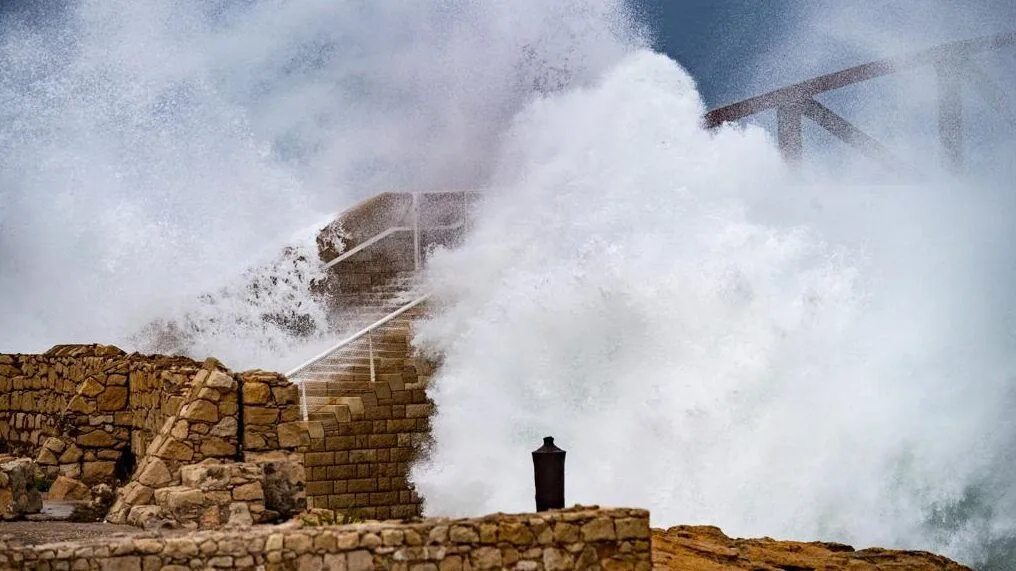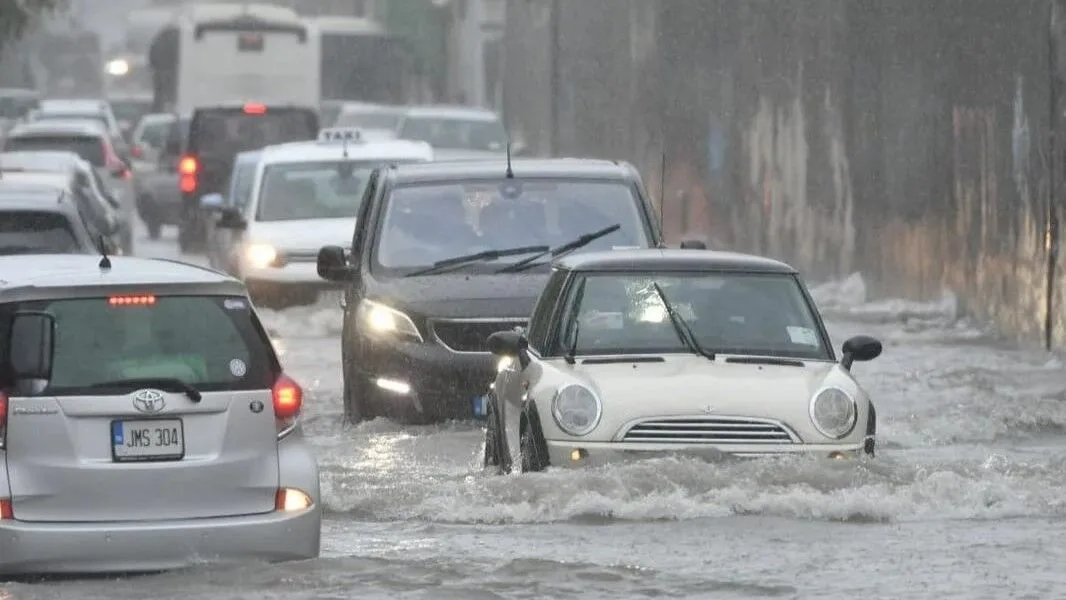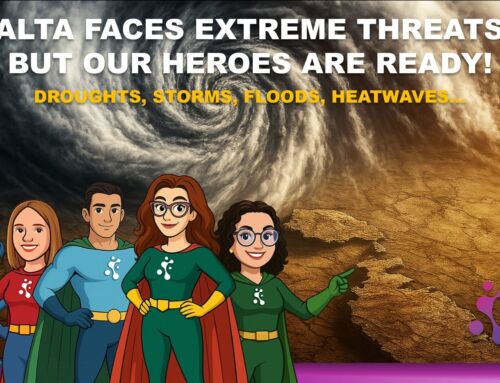The Wrath of Storm Helios and Malta’s Vulnerability
In a dramatic display of nature’s force, Storm Helios struck Malta on the night between the 9th and 10th February 2023, bringing a record-breaking deluge of 44.37 billion litres of rain over the island. This rare Mediterranean hurricane, or “medicane,” triggered severe flooding and infrastructure damage and threatened Malta’s treasured centuries old heritage sites. Storm Helios has left a powerful reminder of the need for Malta to bolster its climate resilience and heritage protection as extreme weather events become more frequent. This editorial examines the storm’s formation, its profound impacts, and the urgent steps needed to safeguard Malta’s future.
Meteorological Origins of Storm Helios and the Medicanes Phenomenon
Medicanes, or Mediterranean cyclones, are a rare type of storm that combine features of both tropical and extratropical cyclones. Forming over the warmer-than-usual Mediterranean waters, these storms resemble small-scale hurricanes and have been increasing in intensity due to climate change. Storm Helios developed over the North African coast, where a low-pressure system intensified over the Mediterranean Sea and formed a compact, cyclone-like system. Helios’s landfall brought torrential rain, gale-force winds, and powerful waves that tested Malta’s preparedness.
The conditions that create medicanes are becoming more common, and scientists attribute this shift to warmer sea temperatures driven by global climate change. Warmer waters fuel these storms with more energy, making them more intense. As temperatures in the Mediterranean Sea continue to rise, experts warn that these medicanes could strike more often, necessitating stronger climate adaptation and mitigation strategies for Mediterranean nations.
Calculating the Impact: 44.37 Billion Liters of Rain on Malta’s 316 km² Surface
The scale of rainfall from Storm Helios is both alarming and unprecedented. Malta recorded 140.4 mm of rain in 24 hours at Luqa, far surpassing the island’s February average of 65.9 mm and setting a new record. To grasp the enormity of this rainfall, we calculated the total volume of water that inundated Malta using its land area of 316 km². Converting millimetres to meters and square kilometres to square meters, we estimate that the storm poured approximately 44.37 billion litres of rainwater across the island.
This deluge overwhelmed Malta’s infrastructure, leaving streets flooded, buildings waterlogged, and drainage systems unable to cope. It underscores the need for a more robust flood management system to handle such extreme events, which are likely to occur more frequently.
Infrastructure and Economic Impact: Damage Across Malta
Storm Helios inflicted severe damage on Malta’s infrastructure and economy. Roads in Bummarad, Birkirkara, Gzira, Sliema, Valletta, and Bahar ic-Caghaq, among others were flooded, ferry services between Malta and Gozo were suspended, and public transportation systems struggled to maintain operations. The powerful winds and surging waves brought down poles, flooded buses, and left vehicles and buildings vulnerable to debris and water damage. The Civil Protection Department (CPD) reported being on high alert throughout the storm, and residents were advised to avoid low-lying areas due to high flood risks.
The economic toll on Helios is substantial. Insured damages alone were estimated at around €1.8 million, covering claims for vehicles, homes, and other insured properties. This figure excludes the broader uninsured costs of infrastructure repair, which are expected to be significant. Malta’s drainage and flood management systems struggled to contain the deluge, highlighting the need to invest in resilient infrastructure to handle future extreme weather.
Heritage Sites at Risk: Historic Damages to Malta’s Cultural Icons
One of the most troubling consequences of Storm Helios is the damage sustained by Malta’s historic sites, which are integral to the island’s cultural identity and tourism economy. Notably, the 17th-century Għajn Tuffieħa Tower suffered structural damage from the high winds and rain, raising concerns about its stability. Additionally, a historic wall in Birgu, a site of considerable historical significance, was severely damaged, prompting calls for urgent repair funds to prevent further deterioration.
These heritage sites are particularly vulnerable. The damage inflicted by Helios on Malta’s cultural landmarks has ignited conversations about the need for preservation strategies that consider the impacts of climate change. To protect these sites, restoration efforts must incorporate climate resilience measures, such as strengthening masonry, adding protective barriers, and conducting regular structural assessments to mitigate future risks.
A Community in Crisis and Resilience in Action
As Storm Helios battered Malta, local communities and agencies rallied together. The CPD, emergency responders, and volunteers worked tirelessly to remove debris, clear flooded areas, and assist those affected by the storm. However, the strain on local resources was evident, and there is a clear need for improved preparedness and resource allocation for future extreme weather events.
The community’s response to Helios demonstrates Malta’s resilience, but the event also highlighted significant gaps in emergency preparedness. Improved early warning systems, public awareness campaigns, and proactive government measures are essential for reducing the impact of similar storms in the future.
Policy and Structural Changes: Building Climate Resilience for Malta
Storm Helios has exposed Malta’s vulnerabilities to extreme weather, from infrastructure shortcomings to the fragile state of its heritage sites. Addressing these challenges requires a multipronged approach that combines policy reform, infrastructure investment, and environmental restoration. Here are three priority areas for enhancing Malta’s climate resilience:
- Resilient Infrastructure: Infrastructure upgrades are critical to protecting communities from future storms. Malta must invest in stormwater systems, flood defences, and resilient roadways, especially in low-lying and coastal areas. Introducing more stringent building codes to require flood-resistant designs will also be crucial as extreme weather becomes more frequent.
- Heritage Preservation and Adaptive Restoration: As seen with the Għajn Tuffieħa Tower and the Birgu wall, heritage sites need targeted protection strategies. Malta should establish funding and policies that support adaptive restoration, restoring sites with materials and methods that can withstand environmental stresses. By strengthening these sites, Malta can preserve its cultural history for future generations despite rising climate challenges.
- Environmental Restoration and Nature-Based Solutions (NBS): Natural coastal defences like wetlands and sand dunes can absorb wave energy and reduce flooding. Expanding NBS will bolster Malta’s natural resilience, complementing infrastructure investments. Restoring damaged ecosystems and creating buffer zones around coastal heritage sites are sustainable strategies to protect natural and cultural assets.
Learning from Storm Helios to Protect Malta’s Future
Storm Helios has underscored the urgent need for Malta to enhance its climate resilience. As climate change drives more frequent and severe storms, Malta’s infrastructure, heritage sites, and communities remain at risk. By investing in resilient infrastructure, strengthening cultural preservation practices, and restoring natural defences, Malta can mitigate the impact of future storms.
The lessons from Storm Helios should serve as a catalyst for change, urging policymakers, conservationists, and the public to prioritize resilience. With proactive planning, Malta can protect its cultural heritage and secure a safer, more sustainable future in an era of climate uncertainty.







